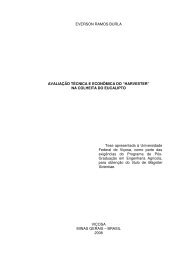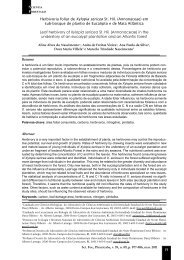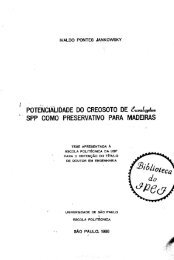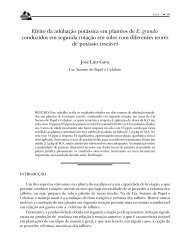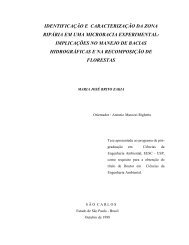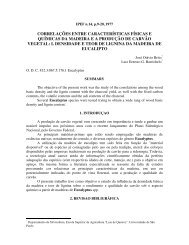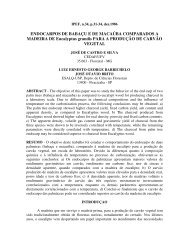Parâmetros de qualidade da madeira e do carvão vegetal de ... - Ipef
Parâmetros de qualidade da madeira e do carvão vegetal de ... - Ipef
Parâmetros de qualidade da madeira e do carvão vegetal de ... - Ipef
Create successful ePaper yourself
Turn your PDF publications into a flip-book with our unique Google optimized e-Paper software.
434<br />
Oliveira et al. – <strong>Parâmetros</strong> <strong>de</strong> quali<strong>da</strong><strong>de</strong> <strong>da</strong> ma<strong>de</strong>ira<br />
e <strong>do</strong> <strong>carvão</strong> <strong>vegetal</strong> <strong>de</strong> Eucalyptus pellita F. Muell.<br />
Proprie<strong>da</strong><strong>de</strong>s <strong>do</strong> <strong>carvão</strong> <strong>vegetal</strong><br />
Foram <strong>de</strong>termina<strong>do</strong>s os rendimentos em <strong>carvão</strong>,<br />
em gases não con<strong>de</strong>nsáveis e líqui<strong>do</strong> pirolenhoso,<br />
em relação à ma<strong>de</strong>ira seca, pelas fórmulas:<br />
Rc = (Pc / Pm) * 100<br />
Rl = (Pl / Pm) * 100<br />
Rg = 100 - (Rc + Rl)<br />
On<strong>de</strong>:<br />
Rc = rendimento em <strong>carvão</strong> (%)<br />
Rl = rendimento em líqui<strong>do</strong> pirolenhoso(%)<br />
Rg = rendimento em gases não-con<strong>de</strong>nsáveis(%)<br />
Pc = peso <strong>do</strong> <strong>carvão</strong><br />
Pm = peso seco <strong>do</strong>s cavacos <strong>de</strong> ma<strong>de</strong>ira<br />
Pl = peso <strong>do</strong> líqui<strong>do</strong> pirolenhoso<br />
A composição química imediata foi <strong>de</strong>termina<strong>da</strong><br />
<strong>de</strong> acor<strong>do</strong> com a Norma ABNT NBR 8112<br />
(ABNT, 1983), com <strong>de</strong>terminação <strong>de</strong> materiais<br />
voláteis, teor <strong>de</strong> cinzas e teor <strong>de</strong> carbono fixo,<br />
em base seca.<br />
A <strong>de</strong>nsi<strong>da</strong><strong>de</strong> aparente <strong>do</strong> <strong>carvão</strong> foi <strong>de</strong>termina<strong>da</strong><br />
<strong>de</strong> acor<strong>do</strong> com Vital (1984) com substituição<br />
<strong>da</strong> água por mercúrio. A <strong>de</strong>nsi<strong>da</strong><strong>de</strong> ver<strong>da</strong><strong>de</strong>ira<br />
foi <strong>de</strong>termina<strong>da</strong> <strong>de</strong> acor<strong>do</strong> com a Norma<br />
ABNT NBR 9165 (1985). A porosi<strong>da</strong><strong>de</strong> <strong>do</strong> <strong>carvão</strong><br />
é obti<strong>da</strong> a partir <strong>do</strong>s <strong>da</strong><strong>do</strong>s <strong>da</strong>s <strong>de</strong>nsi<strong>da</strong><strong>de</strong>s<br />
aparente e ver<strong>da</strong><strong>de</strong>ira, através <strong>da</strong> fórmula:<br />
P(%)=100 - (DA*100)/100<br />
On<strong>de</strong>:<br />
P(%) = Porosi<strong>da</strong><strong>de</strong> em %<br />
DA = Densi<strong>da</strong><strong>de</strong> Relativa Aparente<br />
DV = Densi<strong>da</strong><strong>de</strong> Relativa Ver<strong>da</strong><strong>de</strong>ira<br />
O po<strong>de</strong>r calorífico superior foi <strong>de</strong>termina<strong>do</strong><br />
por meio <strong>de</strong> um calorímetro adiabático, <strong>de</strong> acor<strong>do</strong><br />
com a Norma ABNT NBR 8633 (1983).<br />
A ma<strong>de</strong>ira e o <strong>carvão</strong> <strong>vegetal</strong> foram moí<strong>do</strong>s<br />
em moinho tipo Wiley e em segui<strong>da</strong> em um<br />
pulveriza<strong>do</strong>r para obter amostras classifica<strong>da</strong>s<br />
em peneiras <strong>de</strong> 200/270 mesh. As amostras foram<br />
secas em estufa a 103 ± 2 °C por 24 horas.<br />
Em segui<strong>da</strong> foram pesa<strong>da</strong>s entorno <strong>de</strong> 1 mg <strong>da</strong>s<br />
amostras e leva<strong>da</strong>s a um analisa<strong>do</strong>r elementar<br />
CHN Perkin Elmer II 2400 série CHNS /O, on<strong>de</strong><br />
foram <strong>de</strong>termina<strong>do</strong>s valores para C, N, H e por<br />
diferença o valor <strong>de</strong> O.<br />
Análise estatística <strong>do</strong>s <strong>da</strong><strong>do</strong>s<br />
Utilizou-se o Delineamento Inteiramente Casualiza<strong>do</strong>,<br />
com cinco repetições por tratamento<br />
(marcha <strong>de</strong> carbonização). Para verificar o efeito<br />
<strong>do</strong> tempo e <strong>da</strong> temperatura final <strong>de</strong> carboniza-<br />
Sci. For., Piracicaba, v. 38, n. 87, p. 431-439, set. 2010<br />
ção nas proprie<strong>da</strong><strong>de</strong>s e rendimento <strong>do</strong> <strong>carvão</strong><br />
<strong>vegetal</strong>, os resulta<strong>do</strong>s foram submeti<strong>do</strong>s à análise<br />
variância e quan<strong>do</strong> verifica<strong>da</strong> diferenças significativas,<br />
aplicou-se o teste Tukey, ao nível <strong>de</strong><br />
95% <strong>de</strong> probabili<strong>da</strong><strong>de</strong>.<br />
Para as análises <strong>da</strong> ma<strong>de</strong>ira, aplicou-se a estatística<br />
<strong>de</strong>scritiva para obter o <strong>de</strong>svio padrão e<br />
média geral <strong>do</strong>s <strong>da</strong><strong>do</strong>s.<br />
RESULTADOS E DISCUSSÃO<br />
A Tabela 2 apresenta os valores <strong>de</strong> <strong>de</strong>nsi<strong>da</strong><strong>de</strong><br />
básica, teores <strong>de</strong> lignina, extrativos (solúveis em<br />
álcool/tolueno), holocelulose e po<strong>de</strong>r calorífico<br />
superior <strong>da</strong> ma<strong>de</strong>ira.<br />
Tabela 2. Valores médios <strong>de</strong> <strong>de</strong>nsi<strong>da</strong><strong>de</strong> básica, composição<br />
química e po<strong>de</strong>r calorífico superior <strong>da</strong><br />
ma<strong>de</strong>ira <strong>de</strong> Eucalyptus pellita.<br />
Table 2. Average values of basic <strong>de</strong>nsity, chemical<br />
composition and superior caloric power from<br />
Eucalyptus pellita wood.<br />
Densi<strong>da</strong><strong>de</strong> básica 0,558 g/cm³<br />
Teor <strong>de</strong> lignina total* 29,50%<br />
Teor <strong>de</strong> extrativos totais 4,53%<br />
Teor <strong>de</strong> holocelulose* 65,97%<br />
Po<strong>de</strong>r calorífico superior 4630 kcal/kg<br />
*Valores obti<strong>do</strong>s base ma<strong>de</strong>ira com extrativos<br />
A <strong>de</strong>nsi<strong>da</strong><strong>de</strong> básica média <strong>da</strong> ma<strong>de</strong>ira foi<br />
igual a 0,558 g/cm³, próxima <strong>de</strong> valores encontra<strong>do</strong>s<br />
para outras espécies <strong>de</strong> eucalipto, tradicionalmente<br />
planta<strong>da</strong>s para produção <strong>de</strong> <strong>carvão</strong><br />
<strong>vegetal</strong>. O alto teor <strong>de</strong> lignina total encontra<strong>do</strong><br />
(29,50 %) po<strong>de</strong> ser explica<strong>do</strong> por se tratar <strong>de</strong><br />
ma<strong>de</strong>ira na fase juvenil.<br />
A <strong>de</strong>nsi<strong>da</strong><strong>de</strong> <strong>da</strong> ma<strong>de</strong>ira é <strong>de</strong> gran<strong>de</strong> importância<br />
na produção <strong>de</strong> <strong>carvão</strong> <strong>vegetal</strong>, uma vez<br />
que para um mesmo volume <strong>de</strong> ma<strong>de</strong>ira po<strong>de</strong>se<br />
obter maior rendimento gravimétrico em <strong>carvão</strong><br />
<strong>vegetal</strong> se a <strong>de</strong>nsi<strong>da</strong><strong>de</strong> <strong>da</strong> ma<strong>de</strong>ira utiliza<strong>da</strong><br />
for mais alta. (CARVÃO VEGETAL, 2003).<br />
Segun<strong>do</strong> Vital (1984) a tendência <strong>da</strong> <strong>de</strong>nsi<strong>da</strong><strong>de</strong><br />
básica é aumentar com a maturi<strong>da</strong><strong>de</strong> <strong>da</strong> árvore<br />
como conseqüência <strong>do</strong> aumento <strong>da</strong> espessura<br />
<strong>da</strong> pare<strong>de</strong> celular e diminuição <strong>da</strong> largura<br />
<strong>da</strong>s células. O teor <strong>de</strong> lignina ten<strong>de</strong> a diminuir,<br />
pois as espécies mais jovens ten<strong>de</strong>m a possuir<br />
uma maior proporção <strong>de</strong> ma<strong>de</strong>ira juvenil que é<br />
mais rica em lignina <strong>do</strong> que a ma<strong>de</strong>ira madura.<br />
Os valores encontra<strong>do</strong>s neste estu<strong>do</strong> estão<br />
próximos aos encontra<strong>do</strong>s em outros trabalhos, a<br />
exemplo <strong>do</strong> estu<strong>do</strong> feito por Pereira et al. (2000),<br />
para a espécie <strong>de</strong> E. pellita com i<strong>da</strong><strong>de</strong> <strong>de</strong> 6 anos, no<br />
qual observou valores <strong>de</strong> <strong>de</strong>nsi<strong>da</strong><strong>de</strong> básica igual a<br />
0,587 g/cm³ e <strong>de</strong> teor <strong>de</strong> lignina igual a 31,9%.



